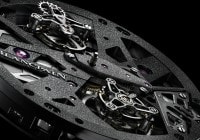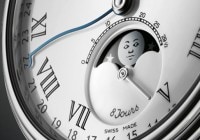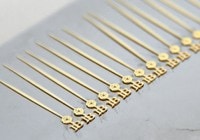
Search in Issues
Chapters
List of parts
Chapter 4
The phase OF THE MOON
A symbol of Blancpain.
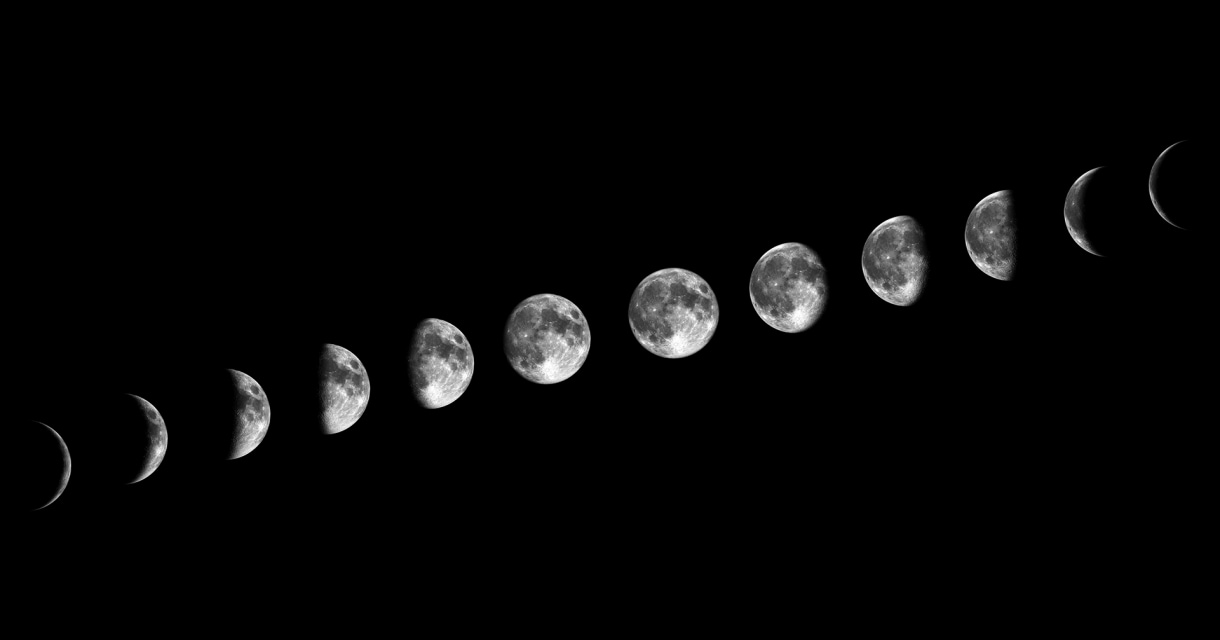
In religion, in calendars and in daily life the PHASE OF THE MOON HAS PLAYED A VITAL ROLE.
There are two orbs that dominate the sky. In order of importance, one of them hugely surpasses the other. Indeed, without this one, life would not exist; as for the other, certainly there would be an altered state of affairs, but the planet would survive. Yet oddly over the millennia, it is the less important of these two celestial objects that has been the more studied by amateurs. Of course, that object is the moon. This is not to say that we have our priorities turned topsy-turvy, as owing to the searing intensity of its light that forbids close study with the naked eye, the sun hardly presents itself as readily as the moon as an object for gazing and contemplation.
Indeed, lending itself so openly to imagination of ancient peoples, some cultures, notably in Mesopotamia, India, and Egypt favored the moon over the sun. Others adopted the moon as a core element of their religion. Naturally, with its constantly repeating progression of phases, the moon has featured prominently in calendars. For thousands of years, and still today, the Chinese calendar is based upon the cycles of the moon. So accustomed are Westerners to the Gregorian calendar, promulgated by Pope Gregory XIII which is based upon the sun, it is forgotten that in earlier times it was the moon that played a key role in western calendar calculations. For example, the Julian calendar adopted by Julius Caesar was based on both the sun and the moon. Prior to that the Roman calendar constructed each month in accordance with the moon, with each phase representing a monthly division. Reaching further back, the ancient Greeks modeled their calendar solely upon the moon, with each month commencing with the new moon and featuring a holiday with every full moon.
Beyond religion and calendars, the phases of the moon have played an important part of daily life. Before modern lighting systems, the full moon, lighting the sky twenty-five times more brightly than, for example, a quarter moon, was favored for nighttime work by farmers who were able to continue their day- time work into the evening. Hence, the origin of the phrase “harvest moon”. Even more broadly beyond agriculture, the ability to prolong activity into the evening under the light of the full moon gave rise to the expression “moonlighting” which is now generally applied to any supplementary work activity.
Knowing the phases of the moon has also played an important role militarily. Julius Caesar favored beginning his attacks under the darkened sky of the new moon, hoping that the darkness would confuse and disorient the enemy. The opposite philosophy guided General Eisenhower in the planning of D day. He selected the day proximate to a full moon needing the extra light to aid paratroopers and glider pilots who were to be dropped behind the lines on the evening before the landings in Normandy.
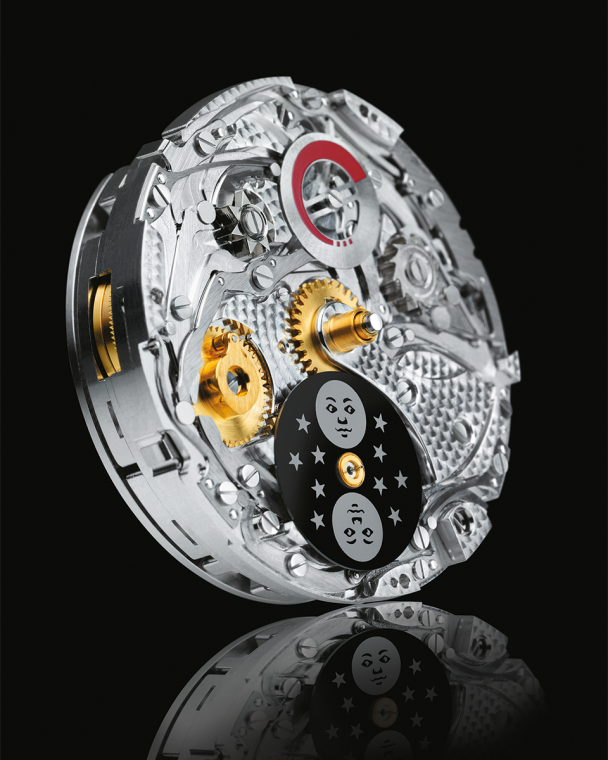
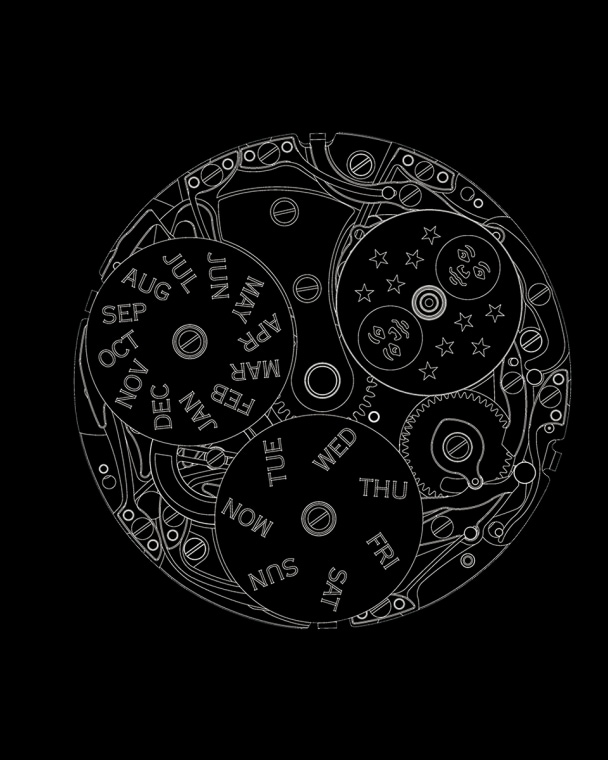
From the OUTSET OF THE CONSTRUCTION OF EARLY TIMEPIECES, depiction of moon phases has been adopted as a central element.
Against this backdrop it is not surprising that, nearly from the outset of the construction of the first timepieces, depiction of moon phases was adopted as a central element. The oldest mechanized device depicting moon phases is thought to have been built by Archimedes, earlier than 200 B.C. Although the device itself no longer exists, references to it do. Cicero’s De Republica discusses globes taken as booty upon Marcus Claudius Marcellus’ capture of Syracuse. Two globes in fact were seized. One placed in the temple of Vesta, the other, spoil of the battle, kept by Marcellus himself. According to the written descriptions, these spherical machines showed the waxing and waning of the moon.
More sophisticated still is the famous Antikythera machine. Fragments of this device, which sank while on board a ship making its way from Rhodes to Rome between 80 and 50 B.C., were discovered in 1901. Now that the modern techniques have been brought to bear in its study, it has become clear that this was a remarkably sophisticated device equipped with a complex gearing system. Not only did it calculate both sidereal and synodic months (sidereal month being defined in reference to a distant star; synodic month defined in reference to the moon), but engravings which appear to be a form of dial contain indications for the phases of the moon and, even more astonishingly, the times of moonrise and moonset.
The next jump in progress moves to Islamic clockmakers working in the 12th century. Clockmaker al-Jazari is said to have constructed a water clock featuring a moon ring with twenty-eight equally spaced holes formed to represent the phases of the moon. Far from autonomous in operation, the clock required a custodian manually to move the moon ring so that the correct phase would be shown. Curiously, at night, a lamp was lit behind the disk so that the display would correspond to the real moon in the night sky.
The DISPLAY of the moon phase with a window and disk DATES TO 1221.
A closer precursor to moon phase clocks came in 1221 with the astrolabe of Muhammad ibn Abi Bakr alIbari of Isfahan. A complex gear train, in many ways resembling modern constructions with its combinations of wheels and pinions, not only enabled indications of the moon’s phase and age, but a representation of the relative positions of the sun and the moon. This geared system and its display disks became the model that endured for centuries in clock designs and, as we shall see, much more. What is particularly noteworthy is that at the back of the clock al-Ibari placed an aperture or window behind which was a rotating disk upon which were placed two dark disks opposite each other. As the disk rotated behind the window, the phase of the moon would wax and wane. The representation of the new moon occurred when the entirety of a dark disk was directly behind the window; for a full moon, the light portion of the disk would be positioned behind. This should strike a familiar ring to watch aficionados, as similar rotating disks behind a window have become the classic way of presenting the phases of the moon in modern wristwatches, including Blancpain’s.
Of course, before appearing in wristwatches, al-Ibari’s display became standard for many clocks and later, with the appearance of pocket watches, for those as well. What is remarkable is that moon phase displays made their way into the very earliest pocket watches. Keep in mind that these primitive first efforts at providing portable time keeping came before the invention of the balance wheel. Thus, these watches were wildly inaccurate as they lacked a precise means of regulating the unwinding of the spring that powered them. Nonetheless, including a moon phase complication was seen as important and was far from rare.
Later, of course, after Dutch mathematician Huygens’s invention of the balance wheel in 1675, which, for the first time, opened up the possibilities to invent escapement systems for accurate timekeeping, moon phase indications joined with other complications to bring interest to the now fully useful timepieces.
Centuries later, the display of the phase of the moon was to play a critical role in horology. In the 1970s, the entirety of the Swiss watchmaking industry had been thrown into crisis. The consumer market became flooded with inexpensive and, it must be said, highly accurate quartz watches. The initial response across the broad expanse of the industry was to dumb down the offerings of mechanical timepieces. In a futile effort to compete with the low cost of quartz watches, Swiss companies stripped away complications from their mechanical watches. However much this removal of complications may have lowered cost, it was a game that mechanical watch houses could not win. No matter what was done, quartz would always be cheaper. One by one, Swiss manufacturers disappeared or sought survival through consolidation.
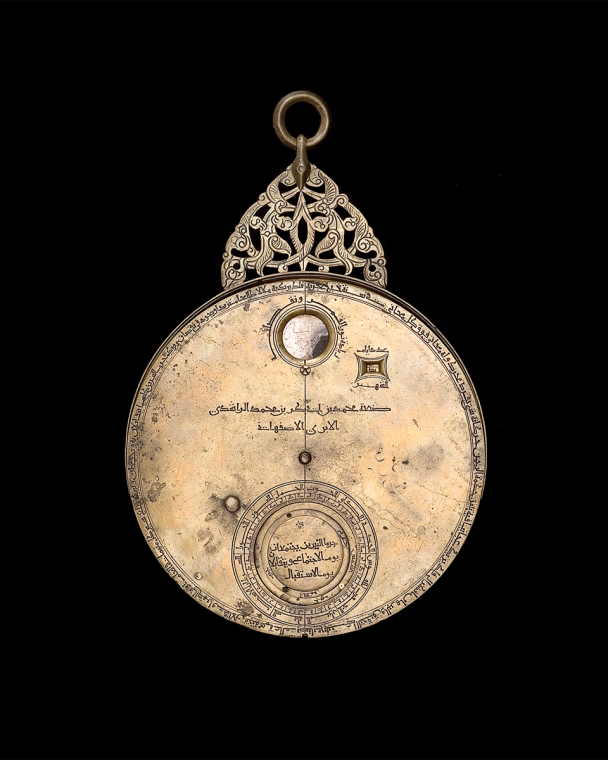
The 1221 astrolabe.
When modern Blancpain emerged in the 1980s, it had a different idea. Rather than competing with inexpensive quartz watches in that segment of the market, Blancpain wanted to demonstrate that a fine mechanical timepiece was something different. It was a rare piece of mechanical art that carried with it beautiful handcraft and centuries of watchmaking tradition. What better way emphatically to make that statement than with a watch offering a display of the moon? Thus, Blancpain, instead of cheapening its Vallée de Joux watchmaking, enrichened it when it introduced its first moon phase watch in 1983. The romance of the display, recalling the rich history of clocks, pocket watches and earlier wristwatches, not only launched modern Blancpain to prominence, it taught other watch houses what they needed to do to combat quartz. The moon phase became the winning formula which allowed mechanical watchmakers to say that a prestige mechanical watch was not at all the same thing as a quartz watch. More than that, Blancpain had shown that no quartz watch could ever be a substitute for a finely made handcrafted timepiece.
Since that pivotal 1983 debut, the moon phase complication has become a symbol or, said another way, a signature of Blancpain. The devotion of the house to the moon has led it to feature the moon phase in more varieties of timepieces than any other watch house.
Naturally, the style of that first model, with a moon phase window at 6 o’clock, day of the week and month in small windows, and date shown with a supplemental hand, has, without interruption, been a fixture in Blancpain’s collections.
There have been many milestones in the evolution of Blancpain timepieces featuring its emblematic and now iconic display:
- increases in the power reserve from 40 to 48 hours;
- the introduction of a 100 hour power reserve model, including the much sought after limited edition half-hunter case version;
- the rare collectible anniversary edition from 2003 with its specially hand carved “man in the moon” winding rotor;
- the first wristwatch in the world offering correctors under the lugs allowing setting of all indications with one’s finger tips while at the same time removing correctors from the side of the watch to achieve a stylish clean profile;
- the introduction of the moon phase to Blancpain’s Women collection;
- with the debut of the L-evolution collection, the first complete calendar/moon phase watch achieving an eight day power reserve and a secure calendar/moon phase mechanism protected from breakage if the owner were to adjust the watch during the changing hours of the mechanism;
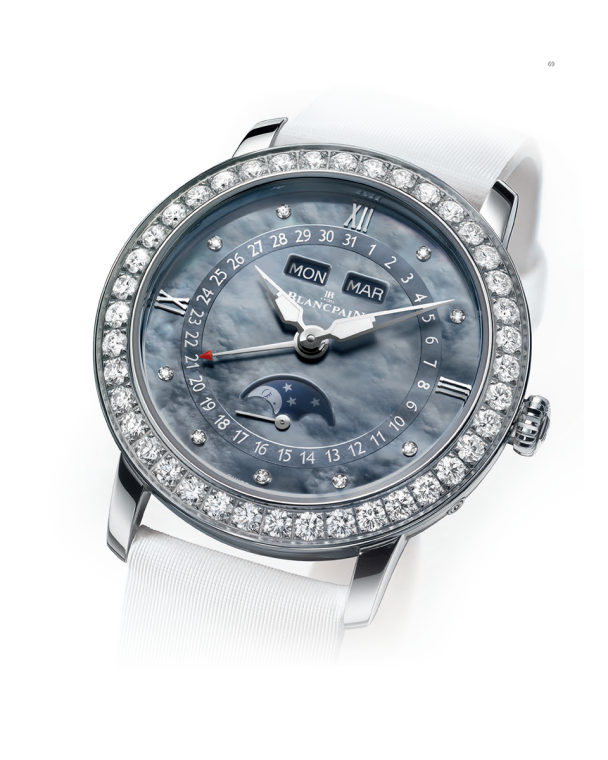
Blancpain Women Quantième Complet.
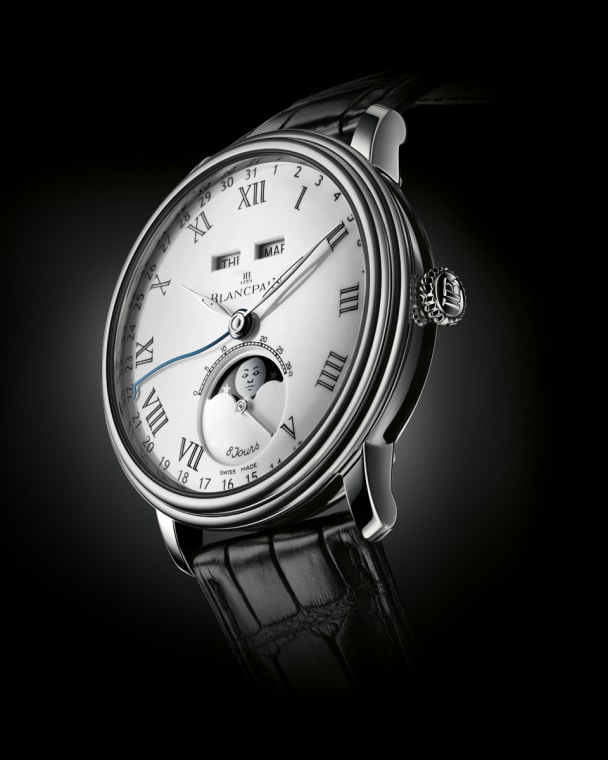
Villeret Quantième Complet 8 Jours.
- the first diving watch with complete calendar / moon phase indication in the Fifty Fathoms collection;
- today’s Villeret model, offering all three of the latest innovations—eight day power reserve, correctors under the lugs, and secure calendar/moon phase mechanism.
Many additional technical improvements have been showered upon the movement over this more than three decade evolution. The balance wheels are now free sprung, with gold regulation screws and equipped with silicium spirals to offer better rate keeping and protection from magnetism. The eight day power reserve models have been designed with three main spring barrels.
Although the progression of models of the now classic complete calendar/moon phase display is important, so, too, is the appearance of the moon phase with other complications. In today’s collections, Blancpain offers the moon phase with a variety of perpetual calendar models. These include in the Villeret collection both the Quantième Perpétuel 8 Jours and the Quantième Perpétuel. Formerly, Blancpain in the Le Brassus collection featured the Quantième Perpétuel Chronographe Flyback à Rattrapante.
Two complicated calendar/moon phase models merit special attention; both are world firsts and remain Blancpain exclusives. The first is the Villeret Équation du Temps Marchante. Not only does this feature a perpetual calendar with moon phase, but when it de- buted in the Le Brassus collection it was the first wrist- watch in history to be equipped with a running indication of solar time (équation du temps marchante). The moon phase for this timepiece is unusual in Blancpain’s collections, in that in place of the classic window with the rotating moon disk behind, the Villeret Équation du Temps Marchante depicts the moon with a retrograde hand pointing to disks upon the dial representing the full moon, new moon and the quarters. Not only when this watch debuted in 2004 was it a world first, it remains exclusive as no other wristwatch today combines these same complications.
There are moon phase timepieces THAT ARE EXCLUSIVE TO BLANCPAIN.
The second Blancpain exclusive piece is its Villeret Calendrier Chinois Traditionnel. As with the Équation du Temps Marchante, this, too, was a world first upon its introduction. Exceedingly complex, the Chinese calendar’s movement combines both Chinese and western calendar indications. The Chinese indications include the zodiac, month, leap month, year, stem yin/ yang, and Chinese hours. On the western side are indications of date and, of course, moon phase. Five hidden correctors have been fitted under the lugs and under the case back for the setting of calendar, which far exceeds a perpetual in its complexity.
There is a third timepiece unique to Blancpain, the Carrousel Volant Une Minute. Initially developed by a Danish watchmaker, Bahne Bonniksen, the carrousel in pocket watches like the tourbillon compensated for rate errors for watches in a vertical position. Hugely successful when introduced, carrousel equipped watches dominated timing competitions, besting the tourbillons of the day. Tragically, the know-how to construct them disappeared until Blancpain revived it in 2008. With a date and moon phase indication, the Villeret Carrousel Phases de Lune is the only moon phase watch in the world with a carrousel.
There is one other important Blancpain moon phase watch to single out: the 1735. Although this limited series of 30 pieces has long since been sold out, it was the most complicated automatic winding wristwatch in the world while it was offered. Housed within its platinum case were a perpetual calendar with moon phase, minute repeater, split seconds chronograph and tourbillon.
The breadth and depth of this range of Blancpain moon phase timepieces is unmatched. But with the key role that the moon phase played in the revival of Blancpain and the remainder of the Swiss watchmaking industry it is only natural that this intriguing and beautiful complication remains center stage at Blancpain.
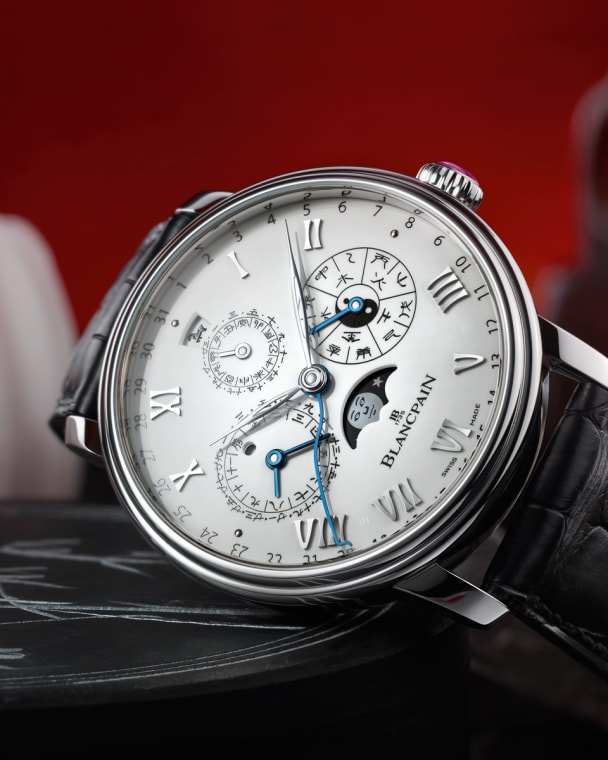
Villeret Calendrier Chinois Traditionnel.
Other issues
Don't miss the latest issue
Sign Up for New Releases

